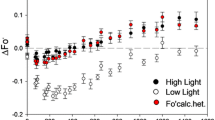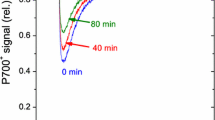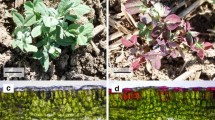Abstract.
Exposure of barley (Hordeum vulgare L.) leaves to strong white light (1500 μmol photons · m−2 · s−1) decreased the quantum yield of photosynthetic oxygen evolution in green light preferentially absorbed by carotenoids (Φ-510) but not in red light exclusively absorbed by chlorophylls (Φ-650). This phenomenon was observed to be (i) rapidly induced (within a few minutes), (ii) slowly reversible in darkness (within about 1 h), (iii) insensitive to dithiothreitol and (iv) maximally induced by photon flux densities higher than about 1000 μmol · m−2 · s−1. Determination of the carotenoid composition of the major light-harvesting complex of PSII (LHCII) and analysis of the thylakoid membrane lipid fluidity before and after strong illumination of barley leaves in the presence or the absence of dithiothreitol showed that the light-induced decrease in the Φ-510/Φ-650 ratio did not require the physical detachment of carotenoids from the pigment antennae. Compared to barley plants grown under moderate light and temperature conditions, plants grown in sustained high irradiance at elevated temperature exhibited (i) a lower Φ-510/Φ-650 ratio, (ii) a reduced size of the functional PSII pigment antenna in green light (but not in red light) and (iii) a marked increase in the amount of free carotenoids found in non-denaturing Deriphat-containing electrophoretic gels of thylakoid membranes. Similarly, the Φ-510/Φ-650 ratio of the LHCII-deficient chlorina-f2 barley mutant was very low compared to the wild type. Separation and quantification of the cis/trans carotenoid isomers of barley leaves revealed that strong illumination did not induce pronounced cis-trans isomerization of xanthophylls. Taken together, the data suggest that the efficiency of energy transfer from carotenoids to chlorophylls varies with the light environment both in the short term and in the long term, with excess light energy noticeably inhibiting the photosynthetic light-harvesting function of carotenoids. The photoprotective significance of this carotenoid decoupling from the chlorophyll antennae is discussed.
Similar content being viewed by others
Author information
Authors and Affiliations
Additional information
Received: 28 July 1997 / Accepted: 25 October 1997
Rights and permissions
About this article
Cite this article
Havaux, M., Tardy, F. & Lemoine, Y. Photosynthetic light-harvesting function of carotenoids in higher-plant leaves exposed to high light irradiances. Planta 205, 242–250 (1998). https://doi.org/10.1007/s004250050317
Issue Date:
DOI: https://doi.org/10.1007/s004250050317




